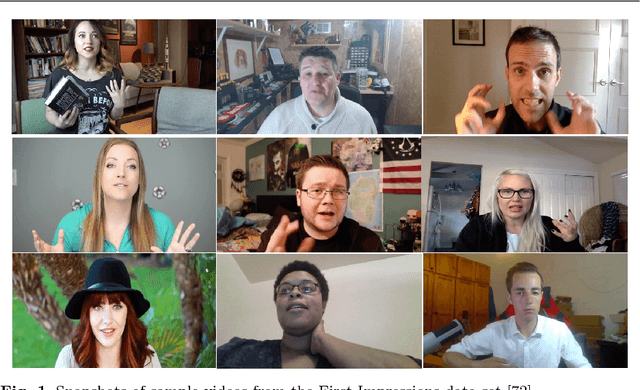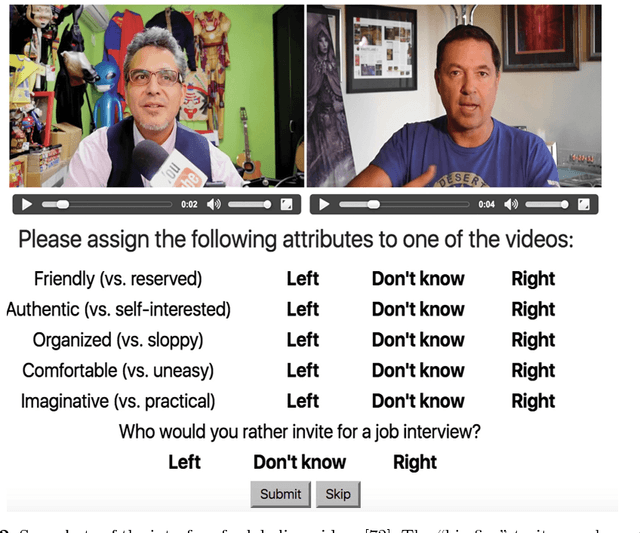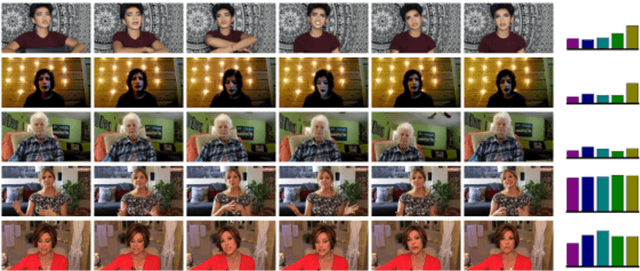Rob van Lier
Explaining First Impressions: Modeling, Recognizing, and Explaining Apparent Personality from Videos
Oct 15, 2018



Abstract:Explainability and interpretability are two critical aspects of decision support systems. Within computer vision, they are critical in certain tasks related to human behavior analysis such as in health care applications. Despite their importance, it is only recently that researchers are starting to explore these aspects. This paper provides an introduction to explainability and interpretability in the context of computer vision with an emphasis on looking at people tasks. Specifically, we review and study those mechanisms in the context of first impressions analysis. To the best of our knowledge, this is the first effort in this direction. Additionally, we describe a challenge we organized on explainability in first impressions analysis from video. We analyze in detail the newly introduced data set, the evaluation protocol, and summarize the results of the challenge. Finally, derived from our study, we outline research opportunities that we foresee will be decisive in the near future for the development of the explainable computer vision field.
First Impressions: A Survey on Computer Vision-Based Apparent Personality Trait Analysis
Apr 21, 2018



Abstract:Personality analysis has been widely studied in psychology, neuropsychology, signal processing fields, among others. From the computing point of view, by far speech and text have been the most analyzed cues of information for analyzing personality. However, recently there has been an increasing interest form the computer vision community in analyzing personality starting from visual information. Recent computer vision approaches are able to accurately analyze human faces, body postures and behaviors, and use these information to infer apparent personality traits. Because of the overwhelming research interest in this topic, and of the potential impact that this sort of methods could have in society, we present in this paper an up-to-date review of existing computer vision-based visual and multimodal approaches for apparent personality trait recognition. We describe seminal and cutting edge works on the subject, discussing and comparing their distinctive features. More importantly, future venues of research in the field are identified and discussed. Furthermore, aspects on the subjectivity in data labeling/evaluation, as well as current datasets and challenges organized to push the research on the field are reviewed. Hence, the survey provides an up-to-date review of research progress in a wide range of aspects of this research theme.
Deep adversarial neural decoding
Jun 15, 2017



Abstract:Here, we present a novel approach to solve the problem of reconstructing perceived stimuli from brain responses by combining probabilistic inference with deep learning. Our approach first inverts the linear transformation from latent features to brain responses with maximum a posteriori estimation and then inverts the nonlinear transformation from perceived stimuli to latent features with adversarial training of convolutional neural networks. We test our approach with a functional magnetic resonance imaging experiment and show that it can generate state-of-the-art reconstructions of perceived faces from brain activations.
End-to-end semantic face segmentation with conditional random fields as convolutional, recurrent and adversarial networks
Mar 09, 2017



Abstract:Recent years have seen a sharp increase in the number of related yet distinct advances in semantic segmentation. Here, we tackle this problem by leveraging the respective strengths of these advances. That is, we formulate a conditional random field over a four-connected graph as end-to-end trainable convolutional and recurrent networks, and estimate them via an adversarial process. Importantly, our model learns not only unary potentials but also pairwise potentials, while aggregating multi-scale contexts and controlling higher-order inconsistencies. We evaluate our model on two standard benchmark datasets for semantic face segmentation, achieving state-of-the-art results on both of them.
Deep Impression: Audiovisual Deep Residual Networks for Multimodal Apparent Personality Trait Recognition
Sep 16, 2016



Abstract:Here, we develop an audiovisual deep residual network for multimodal apparent personality trait recognition. The network is trained end-to-end for predicting the Big Five personality traits of people from their videos. That is, the network does not require any feature engineering or visual analysis such as face detection, face landmark alignment or facial expression recognition. Recently, the network won the third place in the ChaLearn First Impressions Challenge with a test accuracy of 0.9109.
Convolutional Sketch Inversion
Jun 09, 2016



Abstract:In this paper, we use deep neural networks for inverting face sketches to synthesize photorealistic face images. We first construct a semi-simulated dataset containing a very large number of computer-generated face sketches with different styles and corresponding face images by expanding existing unconstrained face data sets. We then train models achieving state-of-the-art results on both computer-generated sketches and hand-drawn sketches by leveraging recent advances in deep learning such as batch normalization, deep residual learning, perceptual losses and stochastic optimization in combination with our new dataset. We finally demonstrate potential applications of our models in fine arts and forensic arts. In contrast to existing patch-based approaches, our deep-neural-network-based approach can be used for synthesizing photorealistic face images by inverting face sketches in the wild.
 Add to Chrome
Add to Chrome Add to Firefox
Add to Firefox Add to Edge
Add to Edge